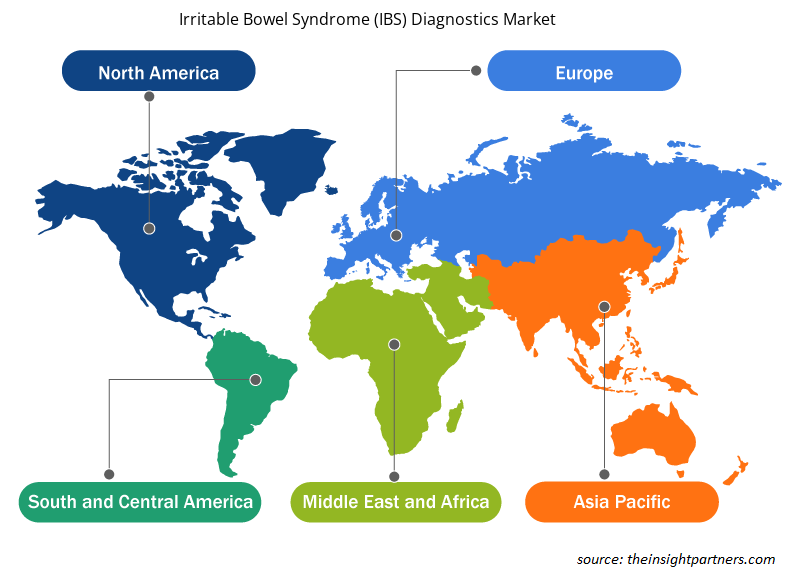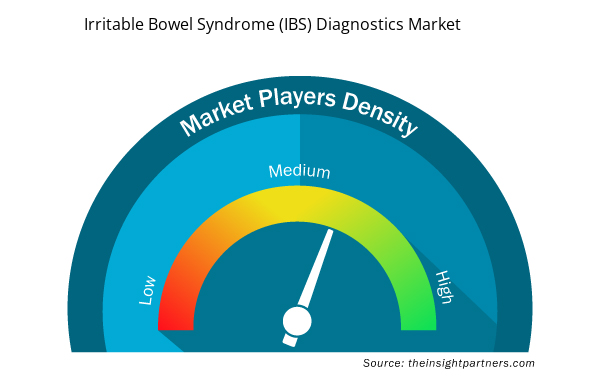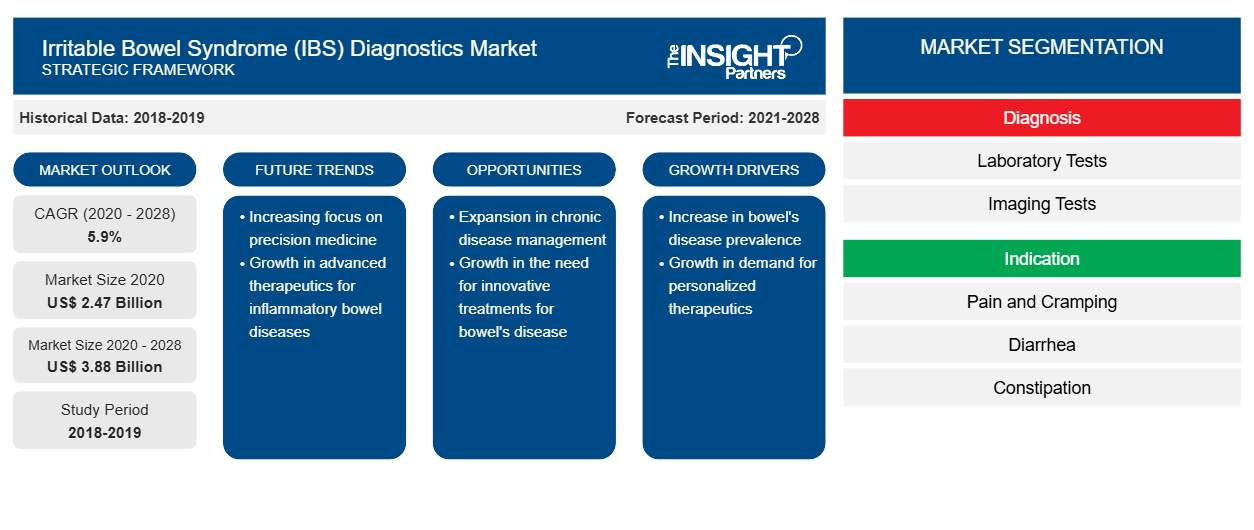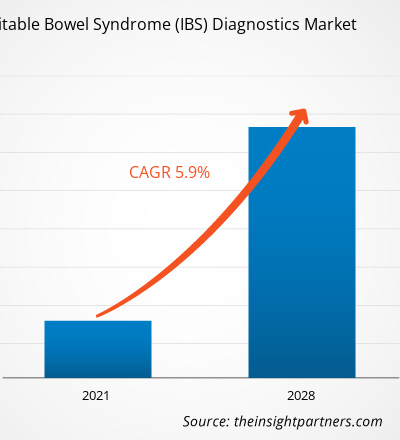Le marché du diagnostic du syndrome du côlon irritable (SCI) était évalué à 2 470,61 millions USD en 2020 et devrait atteindre 3 880,91 millions USD d'ici 2028 ; il devrait croître à un TCAC de 5,9 % de 2021 à 2028.
Le syndrome du côlon irritable (SCI) est défini comme un trouble gastro-intestinal provoquant une gêne gastrique, ainsi que de la diarrhée et de la constipation. Le SCI peut se développer après une grave diarrhée (gastroentérite) causée par des bactéries ou un virus. Le SCI peut également être associé à un excédent de bactéries dans les intestins (prolifération bactérienne). Les personnes exposées à des événements stressants, en particulier dans l'enfance, ont tendance à présenter davantage de symptômes du SCI. Le diagnostic du SCI se fait à partir des antécédents médicaux, d'un examen physique et de tests d'imagerie. Cependant, le SCI est principalement diagnostiqué par des tests d'intolérance au lactose, un test respiratoire pour la prolifération bactérienne, une analyse de sang et un test de selles. Les tests sont effectués en fonction de symptômes tels que la constipation prédominante, la diarrhée prédominante ou mixte. Il peut également être détecté par divers tests d'imagerie tels que la tomodensitométrie ou la radiographie, l'endoscopie supérieure et la coloscopie.
Le marché du diagnostic du syndrome du côlon irritable (SCI) est segmenté en fonction du diagnostic, de l'indication et de la géographie. Par géographie, le marché est segmenté en Amérique du Nord, Europe, Asie-Pacifique, Moyen-Orient et Afrique, et Amérique du Sud et Amérique centrale. Le rapport offre des informations et une analyse approfondie du marché du diagnostic du syndrome du côlon irritable (SCI), en mettant l'accent sur des paramètres tels que les tendances du marché, les avancées technologiques et la dynamique du marché ainsi que sur l'analyse du paysage concurrentiel des principaux acteurs du marché mondial.
Personnalisez ce rapport en fonction de vos besoins
Vous bénéficierez d'une personnalisation gratuite de n'importe quel rapport, y compris de certaines parties de ce rapport, d'une analyse au niveau des pays, d'un pack de données Excel, ainsi que de superbes offres et réductions pour les start-ups et les universités.
- Obtenez les principales tendances clés du marché de ce rapport.Cet échantillon GRATUIT comprendra une analyse de données, allant des tendances du marché aux estimations et prévisions.
Informations sur le marché
Le syndrome du côlon irritable est une affection gastro-intestinale chronique causée par des troubles du transit intestinal et des douleurs abdominales. La maladie est également connue sous le nom de côlon spastique, côlon irritable, colite muqueuse et colite spasmodique. Le syndrome du côlon irritable se manifeste par des symptômes tels que des douleurs abdominales, de la constipation, de la diarrhée et des crampes.
Partout dans le monde, les gens sont témoins d’une incidence considérable du syndrome du côlon irritable. Selon les données publiées par la Fondation internationale pour les troubles gastro-intestinaux, parmi tous les patients atteints du syndrome du côlon irritable, environ 40 % des personnes souffrent d’un syndrome du côlon léger, environ 35 % d’un syndrome du côlon modéré et environ 25 % d’un syndrome du côlon sévère. Les allergies alimentaires, les stades en développement de la gastro-entérite, les mouvements sporadiques du côlon, la composition anormale de la sérotonine dans le côlon et la maladie cœliaque légère font partie des facteurs de risque qui provoquent le syndrome du côlon irritable. Selon une étude publiée sur NCBI en 2018, le syndrome du côlon irritable toucherait environ 10 à 16 % de la population américaine chaque année. De plus, selon le rapport d’impact mondial sur le syndrome du côlon irritable, en 2016, la prévalence moyenne estimée des différents pays variait de 1,1 % en France et en Iran à 35,5 % au Mexique. L'Amérique latine avait un taux de prévalence de 17,5 %, l'Asie de 9,6 %, l'Amérique du Nord/Europe/Australie/Nouvelle-Zélande de 7,1 %, et le Moyen-Orient et l'Afrique de 5,8 %. Une prévalence aussi stupéfiante du syndrome du côlon irritable est susceptible de stimuler le marché du diagnostic du syndrome du côlon irritable (SCI) au cours de la période de prévision.
Pour lutter contre le syndrome du côlon irritable, les acteurs du marché prennent des mesures constructives pour créer des programmes de sensibilisation auprès de la population. Par exemple, en 2018, la collaboration d'Allergan PLC et d'Ironwood a lancé une plateforme de destination numérique interactive pour encourager les patients à s'informer et à agir. De même, en janvier 2018, Commonwealth Diagnostics International, Inc. a collaboré avec le golfeur professionnel américain Rob Oppenheim pour sensibiliser au syndrome du côlon irritable (SCI) et à la prolifération bactérienne de l'intestin grêle (SIBO).
Le nombre croissant d'approbations de la FDA et de développements de diagnostics contribue de manière significative à la croissance du marché
Le nombre croissant d'approbations de la FDA et d'activités de développement de diagnostics devrait accélérer la croissance du marché des diagnostics du syndrome du côlon irritable (SCI) au cours de la période de prévision. La majorité des acteurs établis ainsi que de nouveaux acteurs se présentent pour développer et fabriquer des solutions de diagnostic pour la maladie, ce qui conduira à une large disponibilité des solutions de diagnostic sur le marché. Par exemple, en février 2020, Commonwealth Diagnostics International (CDI), Inc. a relancé l'IBSchek, le premier test sanguin de biomarqueur cliniquement validé pour le syndrome du côlon irritable de type mixte (SCI-D, SCI-M) et la diarrhée prédominante dans un nouveau kit de prélèvement capillaire à domicile. De plus, en octobre 2018, Gemelli Biotech a lancé l'IBS-smart, une innovation dans les tests sanguins pour le syndrome du côlon irritable (SCI), en partenariat avec le Medically Associated Science and Technology Program (MAST) de Cedars-Sinai.
Le marché du diagnostic du syndrome du côlon irritable (SCI) devrait connaître l'approbation de solutions de diagnostic, ce qui aura à terme un impact positif sur la croissance du marché. Par exemple, en juin 2019, BÜHLMANN Laboratories AG a reçu l'autorisation 510(k) de la Food and Drug Administration (FDA) des États-Unis pour son test automatisé de calprotectine BÜHLMANN fCAL turbo et son test ELISA de calprotectine BÜHLMANN fCAL. Selon les estimations de l'entreprise, le test devrait connaître des ventes florissantes sur le marché mondial.
Informations sur le diagnostic
Sur la base du diagnostic, le marché mondial du diagnostic du syndrome du côlon irritable (SCI) est segmenté en tests de laboratoire et tests d'imagerie. En 2020, le segment des tests de laboratoire détenait la plus grande part du marché. De plus, le segment devrait détenir la plus grande part de marché d'ici 2028. La croissance du marché est principalement attribuée à la prévalence croissante du syndrome du côlon irritable (SCI) dans le monde, qui devrait se poursuivre dans les années à venir en raison de troubles des habitudes intestinales et de douleurs abdominales. Cela, à son tour, stimule la demande de diagnostic de ces maladies dans le monde entier.
Informations sur les indications
En fonction des indications, le marché mondial du diagnostic du syndrome du côlon irritable (SCI) est segmenté en douleurs et crampes, diarrhée, constipation et alternance de constipation et de diarrhée. Le segment de la douleur et des crampes détenait la plus grande part de marché en 2020 et devrait encore dominer le marché d'ici 2028. Les antispasmodiques et les antidépresseurs sont des médicaments utilisés pour traiter la douleur et les crampes du SCI.
Les lancements de produits, les fusions et acquisitions sont des stratégies très répandues sur le marché mondial du diagnostic du syndrome du côlon irritable (SCI). Quelques-uns des développements récents de produits clés sont énumérés ci-dessous :
En février 2020, Commonwealth Diagnostics International (CDI), Inc., a annoncé le relancement commercial d'IBSchek, le premier test sanguin biomarqueur cliniquement validé pour le syndrome du côlon irritable à prédominance diarrhéique et de type mixte (IBS-D, IBS-M) dans un nouveau kit de collecte capillaire à domicile.
En janvier 2019, Gemelli Biotech a annoncé un partenariat avec Advanced Medical German Co. (AMG), basé au Koweït, l'un des principaux distributeurs internationaux de produits et services médicaux au Moyen-Orient. Grâce à ce partenariat, AMG distribuera le test sanguin de diagnostic exclusif de Gemelli pour le syndrome du côlon irritable, ibs-smart, dans les principaux territoires du Moyen-Orient et d'Afrique du Nord, notamment le Koweït, les Émirats arabes unis, le Qatar, l'Arabie saoudite, l'Égypte et la Turquie.
La pandémie de COVID-19 devrait avoir un impact positif significatif sur le marché du diagnostic du syndrome du côlon irritable (SCI). La majorité des sociétés pharmaceutiques du monde entier sont engagées dans le développement de vaccins contre la COVID-19. De plus, le syndrome du côlon irritable (SCI) est fréquemment déclenché par le stress lié à la COVID-19. Ainsi, les kits de test à domicile sont préférables aux tests en laboratoire, car les services de laboratoire peuvent être débordés pendant la pandémie, ce qui devrait avoir un impact positif sur les autres segments du marché dans les mois à venir. Cependant, les perturbations de la chaîne d'approvisionnement causées par l'arrêt des opérations mondiales entravent la croissance du marché.
Aperçu régional du marché du diagnostic du syndrome du côlon irritable (SCI)
Les tendances et facteurs régionaux influençant le marché du diagnostic du syndrome du côlon irritable (SCI) tout au long de la période de prévision ont été expliqués en détail par les analystes d’Insight Partners. Cette section traite également des segments et de la géographie du marché du diagnostic du syndrome du côlon irritable (SCI) en Amérique du Nord, en Europe, en Asie-Pacifique, au Moyen-Orient et en Afrique, ainsi qu’en Amérique du Sud et en Amérique centrale.

- Obtenez les données régionales spécifiques au marché des diagnostics du syndrome du côlon irritable (SCI)
Portée du rapport sur le marché des diagnostics du syndrome du côlon irritable (SCI)
| Attribut de rapport | Détails |
|---|---|
| Taille du marché en 2020 | 2,47 milliards de dollars américains |
| Taille du marché d'ici 2028 | 3,88 milliards de dollars américains |
| Taux de croissance annuel composé mondial (2020-2028) | 5,9% |
| Données historiques | 2018-2019 |
| Période de prévision | 2021-2028 |
| Segments couverts | Par diagnostic
|
| Régions et pays couverts | Amérique du Nord
|
| Leaders du marché et profils d'entreprises clés |
|
Densité des acteurs du marché : comprendre son impact sur la dynamique des entreprises
Le marché des diagnostics du syndrome du côlon irritable (SCI) connaît une croissance rapide, tirée par la demande croissante des utilisateurs finaux en raison de facteurs tels que l'évolution des préférences des consommateurs, les avancées technologiques et une plus grande sensibilisation aux avantages du produit. À mesure que la demande augmente, les entreprises élargissent leurs offres, innovent pour répondre aux besoins des consommateurs et capitalisent sur les tendances émergentes, ce qui alimente davantage la croissance du marché.
La densité des acteurs du marché fait référence à la répartition des entreprises ou des sociétés opérant sur un marché ou un secteur particulier. Elle indique le nombre de concurrents (acteurs du marché) présents sur un marché donné par rapport à sa taille ou à sa valeur marchande totale.
Les principales entreprises opérant sur le marché du diagnostic du syndrome du côlon irritable (SCI) sont :
- Commonwealth Diagnostics International
- Diagnostics de Gênes
- Gemelli Biotech
- Laboratoires Prometheus
- Inova Diagnostics, Inc.
Avis de non-responsabilité : les sociétés répertoriées ci-dessus ne sont pas classées dans un ordre particulier.

- Obtenez un aperçu des principaux acteurs du marché du diagnostic du syndrome du côlon irritable (SCI)
Diagnostic du syndrome du côlon irritable (SCI) – Segmentation du marché
Par diagnostic
- Tests de laboratoire
- Tests d'intolérance au lactose
- Test respiratoire pour détecter la prolifération bactérienne
- Analyses de selles
- Analyses de sang
- Tests d'imagerie
- Tomodensitométrie ou radiographie
- Endoscopie supérieure
- Coloscopie
Par indication
- Douleur et crampes
- Diarrhée
- Constipation
- Alternance de constipation et de diarrhée
Par géographie
Amérique du Nord
- NOUS
- Canada
- Mexique
Europe
- France
- Allemagne
- ROYAUME-UNI
- Italie
- Espagne
- Reste de l'Europe
Asie-Pacifique (APAC)
- Chine
- Japon
- Inde
- Australie
- Corée du Sud
- Reste de l'Asie-Pacifique
Moyen-Orient et Afrique (MEA)
- Arabie Saoudite
- Afrique du Sud
- Émirats arabes unis
- Reste du Moyen-Orient et de l'Afrique
Amérique du Sud et Amérique centrale (SCAM)
- Brésil
- Argentine
- Reste de l'Amérique du Sud et de l'Amérique centrale
Profils d'entreprise
- Commonwealth Diagnostics International
- Diagnostics de Gênes
- Gemelli Biotech
- Laboratoires Prometheus
- Inova Diagnostics, Inc.
- Biohit Oyj
- Aérodiagnostic, LLC.
- Solutions métaboliques, Inc.
- Société Sysmex
- Laboratoires Bühlmann AG
- Analyse historique (2 ans), année de base, prévision (7 ans) avec TCAC
- Analyse PEST et SWO
- Taille du marché Valeur / Volume - Mondial, Régional, Pays
- Industrie et paysage concurrentiel
- Ensemble de données Excel


- Drain Cleaning Equipment Market
- Small Internal Combustion Engine Market
- Aerospace Forging Market
- Hair Extensions Market
- Online Exam Proctoring Market
- Employment Screening Services Market
- Nitrogenous Fertilizer Market
- Microcatheters Market
- Electronic Data Interchange Market
- Fill Finish Manufacturing Market

Report Coverage
Revenue forecast, Company Analysis, Industry landscape, Growth factors, and Trends

Segment Covered
This text is related
to segments covered.

Regional Scope
North America, Europe, Asia Pacific, Middle East & Africa, South & Central America

Country Scope
This text is related
to country scope.
Questions fréquemment posées
The factors that are driving growth of the market are increasing prevalence of irritable bowel syndrome and associated conditions and increasing number of FDA approvals and diagnostics developments are anticipated to drive the growth of the global irritable bowel syndrome (IBS) diag nostics market during the forecast period. However, challenges in diagnosis of IBS are hindering the market growth.
The irritable bowel syndrome (IBS) diagnostics market majorly consists of the players such Commonwealth Diagnostics International, Genova Diagnostics, Gemelli Biotech, Prometheus Laboratories, Inova Diagnostics, Inc., Biohit Oyj, Aerodiagnostics, LLC., Metabolic Solutions, Inc., Sysmex Corporation, BÃœHLMANN Laboratories AG are among others.
Irritable bowel syndrome (IBS) is defined as gastro-intestinal disorder causing discomfort in the stomach, along with wind, diarrhoea and constipation. IBS can develop after a severe session of diarrhea (gastroenteritis) caused by bacteria or a virus. IBS might also be associated with a surplus of bacteria in the bowels (bacterial overgrowth). People exposed to stressful events, especially in childhood, tend to have more symptoms of IBS. Moreover, IBS diagnostics is done through medical history, physical exam and imaging tests. However, IBS is majorly diagnosed by lactose intolerance tests, breath test for bacterial overgrowth, blood test and stool test. The tests are done based on the symptoms such as constipation-predominant, diarrhea-predominant or mixed. It can also detect by various imaging tests such as CT Scan or X-ray, upper endoscopy and colonoscopy.
The List of Companies - Irritable Bowel Syndrome (IBS) Diagnostics Market
- Commonwealth Diagnostics International
- Genova Diagnostics
- Gemelli Biotech
- Prometheus Laboratories
- Inova Diagnostics, Inc.
- Biohit Oyj
- Aerodiagnostics, LLC.
- Metabolic Solutions, Inc.
- Sysmex Corporation
- BÜHLMANN Laboratories AG.
The Insight Partners performs research in 4 major stages: Data Collection & Secondary Research, Primary Research, Data Analysis and Data Triangulation & Final Review.
- Data Collection and Secondary Research:
As a market research and consulting firm operating from a decade, we have published and advised several client across the globe. First step for any study will start with an assessment of currently available data and insights from existing reports. Further, historical and current market information is collected from Investor Presentations, Annual Reports, SEC Filings, etc., and other information related to company’s performance and market positioning are gathered from Paid Databases (Factiva, Hoovers, and Reuters) and various other publications available in public domain.
Several associations trade associates, technical forums, institutes, societies and organization are accessed to gain technical as well as market related insights through their publications such as research papers, blogs and press releases related to the studies are referred to get cues about the market. Further, white papers, journals, magazines, and other news articles published in last 3 years are scrutinized and analyzed to understand the current market trends.
- Primary Research:
The primarily interview analysis comprise of data obtained from industry participants interview and answers to survey questions gathered by in-house primary team.
For primary research, interviews are conducted with industry experts/CEOs/Marketing Managers/VPs/Subject Matter Experts from both demand and supply side to get a 360-degree view of the market. The primary team conducts several interviews based on the complexity of the markets to understand the various market trends and dynamics which makes research more credible and precise.
A typical research interview fulfils the following functions:
- Provides first-hand information on the market size, market trends, growth trends, competitive landscape, and outlook
- Validates and strengthens in-house secondary research findings
- Develops the analysis team’s expertise and market understanding
Primary research involves email interactions and telephone interviews for each market, category, segment, and sub-segment across geographies. The participants who typically take part in such a process include, but are not limited to:
- Industry participants: VPs, business development managers, market intelligence managers and national sales managers
- Outside experts: Valuation experts, research analysts and key opinion leaders specializing in the electronics and semiconductor industry.
Below is the breakup of our primary respondents by company, designation, and region:

Once we receive the confirmation from primary research sources or primary respondents, we finalize the base year market estimation and forecast the data as per the macroeconomic and microeconomic factors assessed during data collection.
- Data Analysis:
Once data is validated through both secondary as well as primary respondents, we finalize the market estimations by hypothesis formulation and factor analysis at regional and country level.
- Macro-Economic Factor Analysis:
We analyse macroeconomic indicators such the gross domestic product (GDP), increase in the demand for goods and services across industries, technological advancement, regional economic growth, governmental policies, the influence of COVID-19, PEST analysis, and other aspects. This analysis aids in setting benchmarks for various nations/regions and approximating market splits. Additionally, the general trend of the aforementioned components aid in determining the market's development possibilities.
- Country Level Data:
Various factors that are especially aligned to the country are taken into account to determine the market size for a certain area and country, including the presence of vendors, such as headquarters and offices, the country's GDP, demand patterns, and industry growth. To comprehend the market dynamics for the nation, a number of growth variables, inhibitors, application areas, and current market trends are researched. The aforementioned elements aid in determining the country's overall market's growth potential.
- Company Profile:
The “Table of Contents” is formulated by listing and analyzing more than 25 - 30 companies operating in the market ecosystem across geographies. However, we profile only 10 companies as a standard practice in our syndicate reports. These 10 companies comprise leading, emerging, and regional players. Nonetheless, our analysis is not restricted to the 10 listed companies, we also analyze other companies present in the market to develop a holistic view and understand the prevailing trends. The “Company Profiles” section in the report covers key facts, business description, products & services, financial information, SWOT analysis, and key developments. The financial information presented is extracted from the annual reports and official documents of the publicly listed companies. Upon collecting the information for the sections of respective companies, we verify them via various primary sources and then compile the data in respective company profiles. The company level information helps us in deriving the base number as well as in forecasting the market size.
- Developing Base Number:
Aggregation of sales statistics (2020-2022) and macro-economic factor, and other secondary and primary research insights are utilized to arrive at base number and related market shares for 2022. The data gaps are identified in this step and relevant market data is analyzed, collected from paid primary interviews or databases. On finalizing the base year market size, forecasts are developed on the basis of macro-economic, industry and market growth factors and company level analysis.
- Data Triangulation and Final Review:
The market findings and base year market size calculations are validated from supply as well as demand side. Demand side validations are based on macro-economic factor analysis and benchmarks for respective regions and countries. In case of supply side validations, revenues of major companies are estimated (in case not available) based on industry benchmark, approximate number of employees, product portfolio, and primary interviews revenues are gathered. Further revenue from target product/service segment is assessed to avoid overshooting of market statistics. In case of heavy deviations between supply and demand side values, all thes steps are repeated to achieve synchronization.
We follow an iterative model, wherein we share our research findings with Subject Matter Experts (SME’s) and Key Opinion Leaders (KOLs) until consensus view of the market is not formulated – this model negates any drastic deviation in the opinions of experts. Only validated and universally acceptable research findings are quoted in our reports.
We have important check points that we use to validate our research findings – which we call – data triangulation, where we validate the information, we generate from secondary sources with primary interviews and then we re-validate with our internal data bases and Subject matter experts. This comprehensive model enables us to deliver high quality, reliable data in shortest possible time.


 Obtenez un échantillon gratuit pour ce rapport
Obtenez un échantillon gratuit pour ce rapport